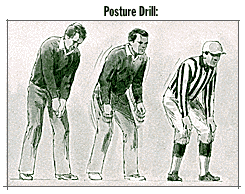If your typical shot flies high and right-to-left, your posture is too straight, either at the knees or waist, causing an armsy swing on an upright plane. On the other hand, if you normally hit low shots that curve left-to-right, you're bending too much and swinging the club too much around your body, resulting in a flat plane.
There isn't a single, perfect plane, but there are boundaries: At the top, your hands should be on line between the top of the left shoulder and the left ear. If you're dropping your hands below your left shoulder, you're swinging too flat. If you're swinging your hands above your left ear, you're too upright.

TROUBLE SPOTS
Watch your knees: Most amateurs don't flex their knees enough. Another common trap is letting the shoulders slump forward: Keep your spine straight and bend forward from the waist.
Check your posture by setting up to an imaginary ball without a club. Relax your arms and let them hang straight down. Your posture is good if your kneecaps are over the insteps of your feet and your fingertips point at the tips of your toes. Fingertips pointing inside the tips means you're standing too straight; point outside the tips, you're too bent over.

POSTURE DRILL:
Assume the ready position of a football referee: feet flat on the ground, knees flexed, spine straight, hands on knees. Gradually straighten at knees and waist enough to hold a golf club.
Posture will be perfect.
